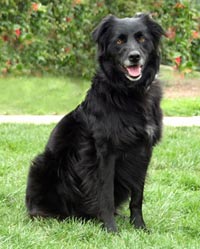Color Me Perfect
The Black Dog and Cat Syndrome
For those of you who have never worked in the animal welfare business, the term “black dog syndrome” or “black cat syndrome” may not be familiar. For the rest of us, we know it well. It’s a term that refers to the lower adoption rate of black or dark-coated animals at shelters. There’s not a lot of hard data regarding the black dog and cat syndrome, but anecdotal evidence suggests this phenomenon is unfortunately real.
Let’s start with black dogs. People seem to have a bad habit of passing up larger black dogs and instead going for ones with light coats. Some speculate that black dogs just don’t have the right look to catch the eye of the public. Others hypothesize that black dogs are hard to see in shelters. The darker the dog, the harder it is to see their eyes-and it has been said that people need to connect with the dog through its eyes. Another reason could be that black dogs can appear older even when they’re not; many have some facial hair that may be white or gray, and this gives the appearance of old age.
I’ve heard people say that black dogs appear ominous. It certainly doesn’t help that in folklore, black dogs are seen as menacing characters that haunt cemeteries. Even in Harry Potter and the Prisoner of Azkaban” a black dog called Grim stalks Harry.
The more black dogs there are at shelters, the more the problem is perpetuated. If a potential adopter sees rows and rows of black dogs, they might think that they’re not being adopted for a good reason and that maybe there’s something wrong with these dogs.
Currently, 25 percent of the dogs up for adoption at the rescue group K-9 Pals are black. One volunteer thinks that mix breeds that are completely black (but aren’t black Labs) seem too unfamiliar, so people tend to pass them over. Only 17 percent of the dogs up for adoption at the Santa Barbara Humane Society are black, though the staff has noticed that the black dogs seem to take longer to get adopted. The rescue group DAWG doesn’t have a ton of black dogs at the present time, but a volunteer stated that three out of four of their black dogs are long-timers.
Black cats are not immune to this syndrome. I recently visited Animal Shelter Assistance Program (ASAP) and counted 11 cats out of 50 that were either black or black-and-white. Just as we see happening with black dogs, black cats don’t catch the eye as much as an orange tabby cat might. The volunteer coordinator at ASAP told me: “I have often had the experience of talking to a potential adopter about a cat and having them refuse to meet the cat simply because it was black. Some of the people associate them with bad luck.” Another volunteer said that potential adopters tell her that all black cats look the same. Donna, a lead volunteer at ASAP, stated that when someone comes into their shelter looking for a kitten to adopt she asks about any preferences as to color, gender, etc. and often they think a bit and respond: “not black.”
Another volunteer at ASAP explained that a phenomenon with black cats is that there tends to be more of them because they are more disease resistant than other cats. An article that appeared in the New Scientist explained that black cats may have a health advantage over other cats: The gene for melanism, which makes their fur black, may be able to prevent certain viruses or bacteria from entering their cells, making them more resistant to disease than cats with lighter-colored coats, according to scientists.
The black-colored animal problem is obviously not with the animals, but with the marketing of those animals. Most shelters come up with creative ways to market their dark-furred animals. I’ve seen festive bandanas tied around black dogs’ necks, and eye-catching blankets lain underneath black cats. I’ve even seen big bow ties around the necks of black male dogs.
Flashy colors do not make an animal desirable in the long haul. What it really boils down to is the animal’s temperament and personality. So the next time you’re visiting your local animal shelter to adopt a pet, remember to ask yourself: “For the next 15-20 years, what will be more important-what color my pet is or what its personality is like?”

Adoptable Dog of the Week
Billie is a five-year-old spayed female black Border collie, 50 lbs. She is very smart. She enjoys the basics-car rides, a yard to hang out in, and a person to hang out with. She has excellent house manners. She is one of the best tennis ball dogs DAWG has seen; she never misses a ball on the fly. Billy needs a dog savvy placement with someone brighter than she is who she will recognize as leader of her pack and who will see the special qualities of border collies. Visit her at DAWG or contact the DAWG volunteer whose home she visits on a regular basis, pfstom@aol.com.
DAWG (Dog Adoption and Welfare Group) is a no-kill not for profit dog rescue/adoption organization located at 5480 Overpass Rd , Goleta . Visit their adoptable dogs at sbdawg.com. The public is invited to stop by and look around during non-public hours every day from 9 a.m. to 4 p.m. We rely on volunteers to take care of out dogs, and students can fulfill their volunteer community service requirement with us. Volunteer orientations are generally held every other Saturday at 10 a.m. Contact DAWG for next meeting, 681-0561.



